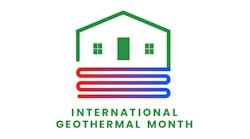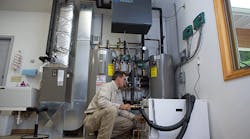Latest from Geothermal
Sponsored
Geothermal retrofit, a perfect fit for Wisconsin home
BAYFIELD, WISC. — For most folks, this home’s simple comfort system was more than ideal. The LP-fired boiler sent its heat into a radiant floor system and, when it was warm, open windows did the job just fine. Sadly, the downside of the simpler approach to heating the home was simply too expensive.
For Bill Gover, a retired plant engineer and his wife Barb, the appeal of tapping geothermal energy from below ground and severing ties with a propane supplier was too enticing to ignore.
Like many people who built in 2003 as the Gover’s did, the concern for energy efficiency was alive, but not worrisome. The 3,000-sq.ft., three bedroom home, three quarters of a mile from Lake Superior and 700 feet above lake level, also had a heated garage and workshop.
“We knew we needed to do something,” said Gover. “During the winter of 2012, before we installed the geothermal system, we were filling the 500-gallon LP tank one, two, or even three times a month in one case. That was the final straw.”
For a few years, Gover had toyed with the idea of solar thermal to assist the boiler. “I really had to fight with that option as a viable investment,” he said. “But I worked with a friend who had a great experience with geothermal, so that tugged me toward geo as the solution we chose to invest in.”
Bill’s research into geothermal systems took him to a broad range of online resources, including Racine, Wisc.-based Modine Manufacturing Co.’s website. “The local contractor I was referred to had experience installing their geothermal systems,” said Gover.
The Govers soon learned from Tony Brown, president of Ashland, Wisc.-based Brown Plumbing & Heating that a single geo system — in this case, a five-ton water-to-water unit — could provide warmth for the radiant heat system while also meeting the Gover’s indoor comfort needs during the mild summer months. Brown also recommended a 50-gal. indirect water heater with electric element as back-up heat to meet the Gover’s domestic water needs.
Brown’s geothermal recipe — using a water-to-water system to do the heavy lifting year-round — works especially well in a part of the country where winters can be serious business, but where summer months are mild. In addition, it’s well-suited for homes in this rural area where propane is expensive and natural gas isn’t available.
“We used a five-ton hydronic coil set on top of an air handler as a source of back-up heat, and also for summer cooling,” said Brown. “This way, the water-to-water geothermal system can provide year-round comfort.
Nelson Mechanical Design swoops in for geothermal system rescue
“We didn’t have a big need for traditional air conditioning in this area up until recent years,” continued Brown. Average summer month highs rarely hit 80 degrees; average lows are in the 50s.
“But when winter rolls in, and especially when the lake freezes to 97 percent coverage as it did last winter, it’s a game-changer,” explained Brown. “We install equipment that will do the job reliably, and do it well. After all, I’ve got to hang my reputation on it. We serve several small and medium-sized communities; word gets around.”
Trenched geo: watch those trees
Even with a wooded lot, the Govers chose to dig a horizontal exchange field — favoring that over deep, vertical geoexchange wells because of the lesser cost. The excavators initially wanted to remove more trees to accommodate the 50’ x 90’ bed, dug to a depth of 10-ft. to 12-ft., but the Govers held their ground: only four trees would be sacrificed.
About 5,000 lineal feet of geothermal tubing, in slinky coils, were installed in five separate trenches. When the tubing installation and deep trenching was complete, it looked like a war zone to the Govers. They wanted to restore the property’s beauty quickly, so when the topsoil was replaced, they cleaned up the surface debris and planted a variety of native plants.
“We’re eager to see it again in full bloom,” said Gover. “The area now serves as an enjoyable green-space eight months of the year — as well as the source for BTUs, harvested underground.”
A few months later, however, green leaves faded and fell, a clue to the coming of winter. Light snow was already on the ground when the full effect of the polar vortex hit. The unexpectedly long duration of the weather condition drove natural gas, LP and fuel oil prices higher.
“Worst of all was the leap in price for LP gas,” said Gover. The cost for fuel doubled, then soon tripled. Because of a declared “shortage,” limits were placed on deliveries. Some dealers told customers that because of the run on fuel nationwide, deliveries would be delayed and that they could provide only 200 gallons a month until the emergency lifted.
When they saw the coincidence of their newly-won energy independence, free from the giant spike in the cost of LP gas and limited availability, the Govers heaved a sigh of relief.
“We certainly couldn’t afford LP prices like those, and the limit of fuel we could purchase —if we could get it — would have been another concern,” said Gover.
“We estimate annual savings of about $1,100 to $1,300,” added Gover. He explained that, though they have tracked utility and energy expenses carefully, last winter’s severity —and greatly fluctuating costs for electric service and LP gas — has made it a challenge to accurately predict future savings. Also, they’re very happy with the return from their geothermal system.
So while others were struggling with the reality of dwindling energy reserves and sky high prices in the face of an uncommonly brutal winter, the Govers luxuriated in the radiant warmth that came from energy harvested in their back yard.
Geothermal — a specialty
Tony Brown says that one of the core specialties of his firm is geothermal heating and cooling— mostly residential work, though with a mixed bag of light commercial systems as well.
“We work with reputable drillers and excavators who take their geoexchange work seriously,” said Brown. “Beyond the important decision about the equipment that’s installed, the quality of the geoexchange is the most important facet of the system, and the biggest investment.”
Brown explained that the Gover’s geo-field will also improve in performance in the years to come.
“The improvements will be gradual; maybe even unnoticeable to them,” said Brown. “But it’s proven that a trenched, or bed, geoexchange field —as it fully collapses, improving contact with the pipe — will improve overall system efficiency.
Brown’s technicians install only Modine geothermal equipment.
“Years ago, we standardized on Modine technology and haven’t looked back since,” he said. “A key difference is the Orb controller. It’s intuitive, offering information in plain English with no codes and also gives easy access to information about what the unit’s doing, any faults that may affect operation, ground and exiting loop temperatures, system pressures, and the unit’s entire service data.”
Polar Vortex, Hidden Treasure
Though the Govers live near the shores of Lake Superior, they need to travel several miles to the peninsula where trails lead to the water’s edge —rather, solid ice last winter — during the sustained deep freeze of last year’s polar vortex. The National Park Service estimated that 138,000 people made the trek to experience one of the lake’s rarest and most spectacular features last winter: the ice caves of Apostle Islands, accessible by walking, or on skis or snow shoes across solid a mile-and-a-half of solid ice.
At Apostle Islands, the frigid temperatures create great beauty. Those who are willing to trudge across Lake Superior's frozen surface are being rewarded with a stunning display of ice formations.
Geologists explain that the one-billion-year-old sandstone is full of cracks. Lake water seeped in and froze on the walls and ceilings.
"It's unique to see water and stone in so many different forms, colors and sculpted variation,” said Gover.
Winter access to the caves is only possible when the ice is thick enough to safely walk on. Conditions haven’t been right for this to happen in five years, and some fear the unusual event could become even rarer.
Along the shore of Lake Superior, sea caves cool off in the winter months, allowing thousands of icicles to form on the inside. For the first time in half a decade, Lake Superior’s caves were accessible. Tourists and media representatives from around the world came to enjoy the spectacle.
But for those lucky enough to enjoy last winter’s ice show, it was a winter wonderland, frozen in time.
Meanwhile, just a few miles away, geothermal warmth circulated for the first time below the floors of the Gover’s home.
“We returned from a trip to the caves with ice cold toes,” said Gover. “It wasn’t long before our new mechanical system warmed us generously.”
In this part of the world, nature’s contrasts never cease to amaze.





